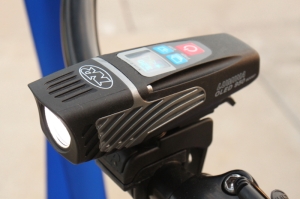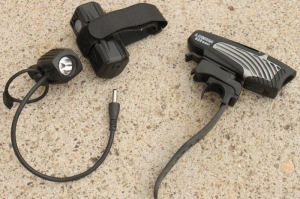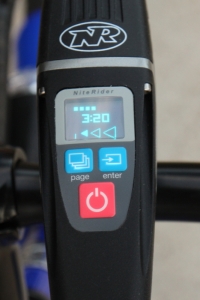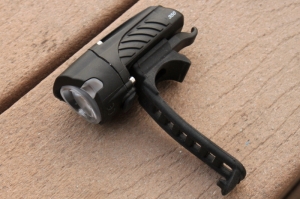NiteRider Lumina OLED 950 Boost (and Swift 350)—Morphed to Perfection.
When my wife and I first started bike commuting 10 years ago, we decided to let NiteRider guide our way during the dark hours. Sure, I had owned bike headlamps before that, yet they were all pretty much a joke as far as actually seeing the road. That pair of MiNewt Mini lights were incredible and really made our riding safe. They were smart, convenient and at the time, I thought played at the pinnacle of their game.
Four years ago we upgraded to a pair of the NiteRider Lumina lights (a 500 and a 650). Wow, they were so much better, in so many ways. We really didn’t take advantage of the extra brightness as much, but reveled at the better design and working features. They incorporate many of the same changes that make the Boost and Swift better, yet not all of them. Once again I figured these were the best and there wasn’t anyway to top their design and usefulness. Wrong again.
Now with this Lumina OLED 950 Boost, I am seeing that NiteRider has upped their game to a point I am most impressed with. I will do my best to point out the changes, why I like them, and how they affect my riding. I also got the Swift 350 (which for some might be a way better choice), and the Lumina 950 Boost too. When it comes to riding at night, these lights are great—and as we use blinking front lights in the daytime, they really do the job there too.
By far, the most obvious change from those MiNewt Minis is the all-in-one housing and light. Those old lights had a separate light and battery unit. That wasn’t a big deal, yet I think we can all appreciate the ease of dealing with just one piece, not two. As we only used those at night (they didn’t blink), they came off the bike most of the time and we kept them in a nice carry bag that my wife made out of some scrap material. So, two items to install, not too hard as the battery was held by a Velcro strap, and the light used a big special O-ring.
As far as mounting goes, the newer Lumina lights were better, with just one unit to mount, but they way they hooked to the bars was different. They used a knurly knobby, (a knurled knob), to tighten the unit to the bars. It works well and fits all sizes of bars, yet the many turns the knob takes to do the job took a bit of time. The new OLED and Boost use a single pull stretchy strap that gets it all done in a jiff. It too should fit all sizes of bars. At first glance I thought it may not hold the light to the bars well, but have since found they work great in that regard, The Swift is similar, yet just a bit different.
One of the better changes I like with the newer Lumina, and now the OLED, Boost and Swift is the way they charge and how you can tell when they are charged. The MiNewt Mini had no indicator. You charged for 4 ½ hours and then had light for 3 hours. The only indicator was when the charge was running low the light would get dimmer. They came with their own plug-in (to the wall) charger, yet no real way to determine when it was done charging. The newer Luminas upped that with a illuminated power button that changed colors when it was fully charged (and a USB cable instead of a transformer for charging).
So that added peace of mind for battery charging. Plus that same light would let you know when there was 20% power left during use. The new OLED, Boost and Swift go one step further with intellicharge. It can determine the output of the charge source and charge twice as quickly when that charge source can deliver. On last thing about the OLED (and there is a bunch more there), the OLED has a display that tells you all you need to know about your charging and power left at all times.
Of course all three of these new lights are way bright with long run times. In the attached videos I covered the lumens and run times, and you can also look on the NiteRider site for that same info. I think our original MiNewt Minis were 350 lumens, which really is bright enough for most riding. When we moved on to the Luminas, we normally would just use the lowest (or one up) setting, as high was always more than we need. The OLED and Boost will punch out 950, really bright. They will only do it for less than an hour and you don’t need that much light, yet they will do it.
I do like a front light that will blink. In the daytime I think that is a big key to getting the attention of oncoming vehicles and ones that might turn your way (opening doors too) . The Lumina, the OLED, the Boost and the Swift all do it. In fact the OLED has different blink modes, including one that pumps out an SOS signal, cool. Another thing they do is offer a lock-out mode. These lights get pretty hot in the higher settings, so NiteRider is very big on the lights not coming on when they are stowed. So please, take advantage of that mode whenever the lights are not mounted to your bike.
What makes the OLED stand out even more is the LCD readout screen that is filled with important information. As far as I can tell, both the Lumina 950 Boost lights are the same, with the exception that the OLED has the display. The info on the screen is very helpful to understanding charge and run times. It also shows you the mode you are using. The OLED is controlled with more than just the one button, something I think helped.
Like many things nowadays, the NiteRider uses instructions that are illustration oriented for every language there is. This can be a bit confusing, yet a quick call to them will clear up any of that and get you full access to all the modes and ways the lights can make your rides better. And those instructions are needed to be able to make these lights work with all the modern changes they have been through. Our original NiteRider MiNewt Minis were simple. One button on—one button off. These do that, yet do so much more.
So my point here is (I guess), that with changes come good things. Those original lights did so much for us. They worked well (and are still working after all this time). They were easy to use. They lit the road nicely for a safe and smart ride. They took away the potential stress of night riding and equipment that might fail when needed. As the years went by NiteRider has worked hard to offer the same quality, yet with much better results. I for one (and my wife for two), have been on the receiving end of their persistent push for the best.
One last thing. The Swift 350 has been perfect for my wife’s commuter bike. It blinks for the day rides, and is a very bright light if she has to ride when it’s dark. My favorite part (and maybe hers) is that because it is so inexpensive, she can just leave it on the bike when parked. Its black housing blends in well with her black handlebar bag so it is pretty stealthy. It gets charged once a week. It is compact and does exactly what we want it for. That is the definition of perfection.
I love the peaceful feeling I get riding at night. Let NiteRider help, Turbo Bob.
“Be at one with the universe. If you can’t do that, at least be at one with your bike.”—Lennard Zinn.
You can find NiteRider at their website or Facebook page.
Here are some videos I posted on the 3 lights I just tested.







This looks amazing, I am not sure I want to spend this type of money though and wondering what you think is really needed as far as lumen output for riding at night on the streets of San Diego.
For most of our night riding we use our NiteRider Lumina 500 and 650 at the low or mid setting. So I guess about 300-500 is more than you need unless you ride real fast.